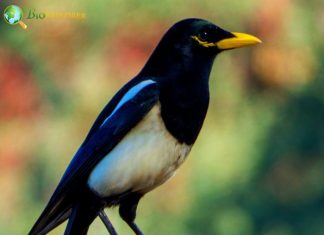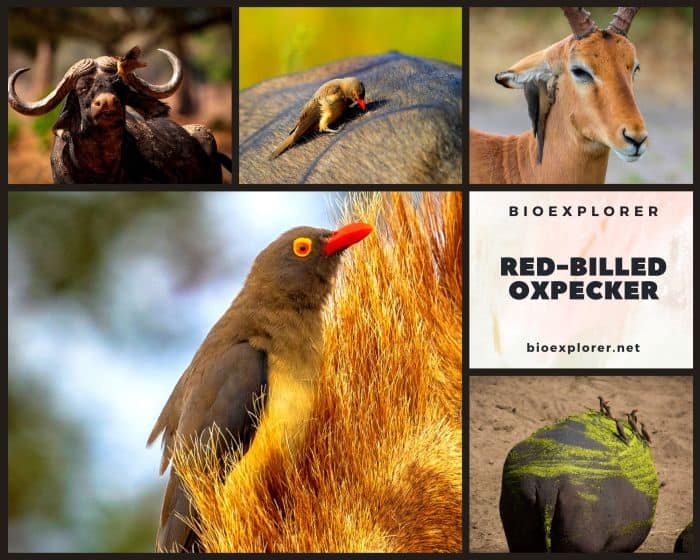
| Animalia | Aves | Passeriformes | Buphagidae | Chordata | Buphagus erythrorhynchus |
Key Takeaways
- Red-billed Oxpeckers are iconic-looking birds with specialized claws and spear-like beaks to perch on animals and eat parasites.
- They provide a valuable cleaning service for impalas, buffalo, giraffes, and other hosts by eating ticks and flies.
- Their bright red eyes, yellow wings, and loud chatter make oxpeckers stand out in the African savanna.
- Oxpeckers have an interdependent, symbiotic relationship with their mammal hosts.
- While still relatively common, habitat loss threatens oxpeckers’ specialized ecological role.
![]()
Table of Contents
- Key Takeaways
- Red-billed Oxpecker Physical Characteristics
- The Oxpecker’s Distinctive Appearance
- What Do Red-billed Oxpeckers Eat?
- What Eats Red-billed Oxpeckers?
- Oxpecker Behavior and Nesting Habits
- Red-billed Oxpecker symbiotic relationship
- Red-billed Oxpecker makes communication and alarm call
- The Oxpecker’s Unique Ecological Niche
- Conservation Efforts and the Oxpecker’s Future
- Threats Facing Red-Billed Oxpeckers
- Red-billed Oxpecker are cooperative breeders
- Key Facts and Figures About Red-Billed Oxpeckers
- Fun Facts About the Red-Billed Oxpeckers
- Frequently Asked Questions
- What does a red-billed oxpecker do?
- Are red-billed oxpeckers carnivores?
- Are red-billed oxpeckers endangered?
- Where are red-billed oxpecker found?
- Are oxpeckers parasitic or mutualistic?
- What advantage does the red-billed oxpecker have why is it an advantage?
Nearly anywhere in sub-Saharan Africa, you can find a herd of grazing animals and often see red- and yellow-billed oxpeckers (Buphagus erythrorynchus) riding on top of them. The ticks they consume and the blood they draw are enjoyable to the birds.
These black birds assist grazers in getting rid of parasites but also expose wounds to infection. The loud warning hiss that birds make when predators are nearby may be the birds’ most obvious benefit.
These highly social birds use their specialized adaptations to perch on large wild mammals such as impala, giraffe, buffalo, and rhino to eat ticks, flies, and other parasites. Oxpeckers have a mutualistic relationship with their hosts, providing cleaning services and alarm calls in exchange for food and transportation. Their range overlaps many iconic African animals across Botswana, Tanzania, Malawi, Mozambique, and South Africa.
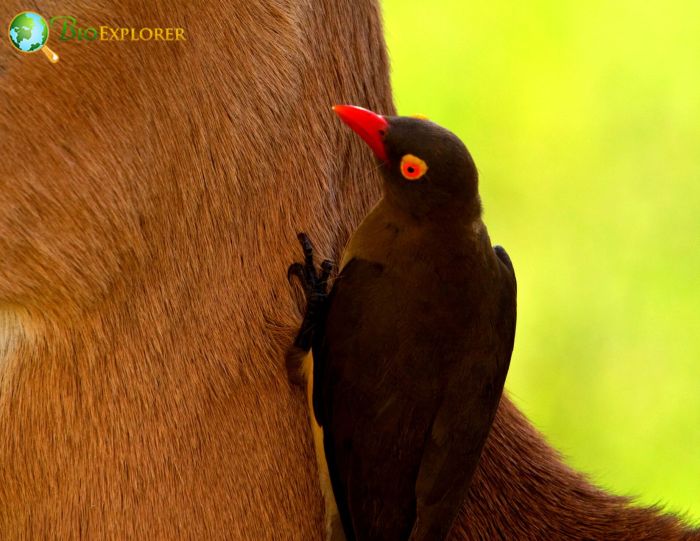
Red-billed Oxpecker Physical Characteristics
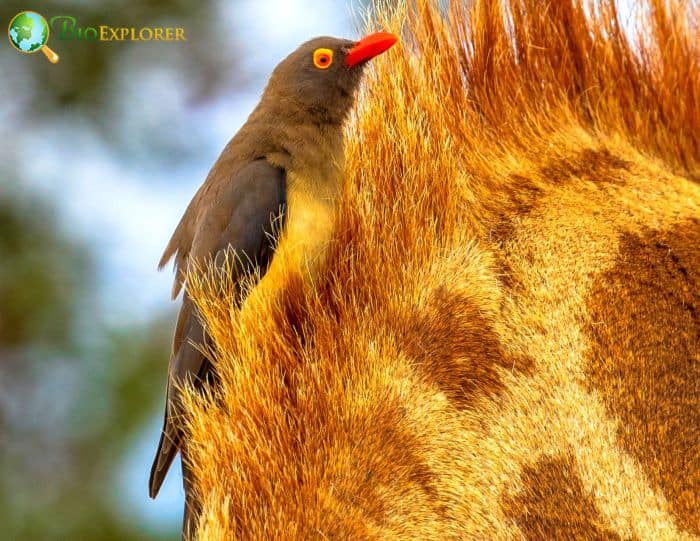
The red-billed oxpecker is a passerine bird found in the savannah of sub-Saharan Africa. It has olive-brown feathers and stands approximately 0.2 meters (7.87 inches) tall, weighing around 0.05 kilograms (0.7 ounces) when fully grown. Its distinctive features include a bright red beak and eyes with yellow[1] rings.
Juvenile oxpeckers are darker brown than adults, and their bills initially have a dark olive color that gradually changes to an adult color after four months. With strong legs and long, sharp claws, the bird can cling to the fur of animals while foraging for parasites.
The red-billed oxpecker has specially adapted tail feathers that are stiffened, serving as a tripod to support itself against the bodies of its hosts during feeding. It nests in tree holes lined with hair plucked from livestock and typically lays 2-5 eggs[2], with an average of three. Its flight is strong and direct, and its call is described as a hissy crackling sound, often represented as “trik-quisss“.
Suggested Reading:
Yellow-billed Magpie
Species Name: Pica nutalliThe Oxpecker’s Distinctive Appearance
The red-billed oxpecker stands out with its vivid coloring and unique features.
- It has bright yellow underwings and belly contrasted by dark brown upperparts and a black throat and rear neck. The oxpecker’s most distinctive marker is its bright red beak, which matches its piercing red eyes.
- Oxpeckers are medium-sized birds, averaging 15–18 cm (6-7 inches) in length with a wingspan of around 30 cm (1 foot). They are similar in size to common starlings. The red-billed species has a larger beak and wings than related yellow-billed oxpeckers.
- This oxpecker’s elongated, spear-shaped bill has hair-like bristles used to help extract ticks from mammals’ skin. Their nostrils are slit-like to keep out dust on the savanna.
- Oxpeckers also have very strong toes and sharp, curved claws specially adapted to perch on large animals and cling to their hide. The claws are significantly larger and sharper compared to other perching birds.
- The oxpecker’s unique morphology gives it an iconic and instantly recognizable look. The bright red beak paired with yellow wings makes the oxpeckers stand out against the tan and brown backdrop of the African savanna.
These specialized traits equip the bird for its acrobatic mammal-riding niche.
![]()
What Do Red-billed Oxpeckers Eat?
The red-billed oxpecker has an extremely varied diet centered around eating parasites and other small prey found on large wild mammals.
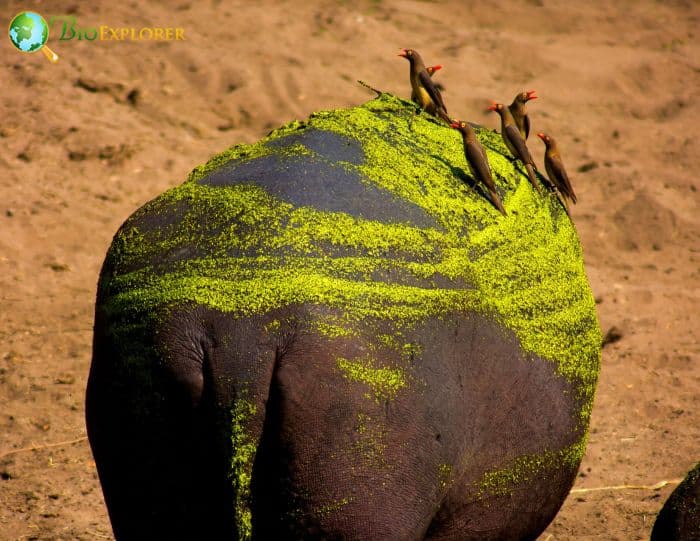
- Their primary food source is ticks such as the brown ear tick, bont tick, and blue tick. Oxpeckers can consume over 100 blood-engorged ticks daily.
- They use spear-shaped beaks to strategically remove ticks embedded in an animal’s skin, providing a valuable cleaning service. The birds will also feed on blood from open wounds on the mammals if no parasites are available.
- Beyond ticks, oxpeckers eat a diverse range of other insects and arthropods living on their hosts. This includes flies, fleas, maggots, mites, spiders, worms, beetles, butterflies, cockroaches, mosquitoes, and larvae.
- Oxpeckers supplement this diet by occasionally eating vegetable matter such as seeds or berries. They have also been observed feeding on the eggs and nestlings of small birds that nest in cavities of trees used by larger mammals. The red-billed oxpecker has a more varied, omnivorous diet than related species.
This adaptation allows them to thrive by exploiting small prey sources and food on their large mammal hosts. The oxpecker niche provides an abundant, constant food supply.
![]()
What Eats Red-billed Oxpeckers?
Despite dining on ticks and other small prey, red-billed oxpeckers fall victim to larger predators in the African savanna ecosystems.
- Birds of prey are the primary predators of oxpeckers in flight. This includes hawk and eagle species such as the African hawk-eagle, martial eagle, tawny eagle, and steppe eagle.
- Snakes like the boomslang and African rock python also prey on oxpeckers, as do jackals and mongoose species when given the chance.
- The greatest danger is to their chicks and eggs, which are vulnerable in nests to predation by snakes and small carnivores like genets.
Oxpeckers cannot utilize their mammal-perching niche when nesting or migrating between areas, increasing their exposure. Their preferred tree hollow nest sites offer limited protection. Loss of nesting sites and habitat degradation also boost pressure from predators.
To deter predators, oxpeckers will mob much larger species in big groups while making shrill alarm calls. This mobbing behavior serves to distract and drive potential predators away through harassment. But despite their defenses, oxpeckers must remain vigilant to avoid surprise attacks in the exposed savanna.
![]()
Oxpecker Behavior and Nesting Habits
Red-billed oxpeckers are highly social and travel in noisy, chattering flocks ranging from just family groups up to 50 birds or more.
- Red-billed oxpeckers communicate constantly with sharp calls to signal warnings, maintain contact, or sound alarms.
- Oxpeckers roost together at night and disperse during the day to find mammal hosts. They perch on impalas, giraffes, rhinos, buffalo, and other large animals found on the African savanna and bushveld. At times, they may also follow domesticated livestock like cattle.
- These African birds build unique nests out of straw, manure, and mammal hair in a round, cup-like shape. The nests are made in natural tree cavities, old woodpecker holes, or similar hollows and lined with leaves, grass, and fur.
- The breeding season varies based on rain, which impacts the food supply. In Southern Africa, egg laying typically peaks from October to December during the spring and early rainy season.
- The female lays between 2-5 eggs which she incubates for 14-16 days while the male helps feed her. Both parents feed the chicks.
![]()
Red-billed Oxpecker symbiotic relationship
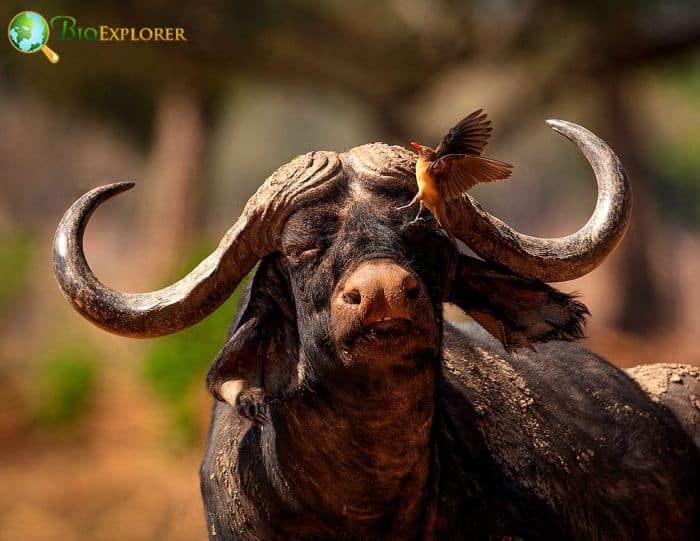
The hosts of the oxpecker bird are large mammals.
- There are two species of oxpeckers in the area. They coexist with various herbivores, from small Warthogs and Impalas to large Giraffes, buffalo, and Rhinos.
- These birds engage in a win-win arrangement known as mutualistic symbiosis, picking and eating parasites from their hosts’ skin during the day. There are several benefits to the relationship for both species.
Red-billed Oxpecker makes communication and alarm call
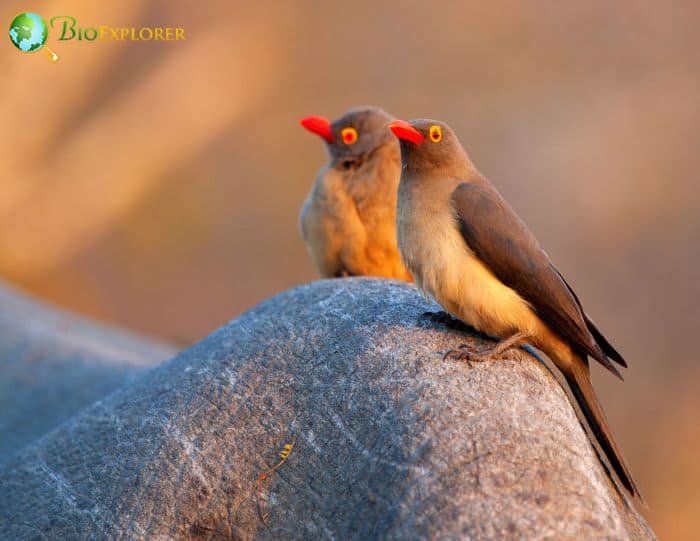
Oxpeckers can benefit hosts by producing alarm calls when identifying predators. Oxpeckers are friendly birds that communicate by whistling and chattering.
- Typically more alert than most large animals, birds rise loudly, hiss, and rasp when startled.
- The animal will typically respond by looking up and away from the threat. This also serves the dual purpose of alerting people to the possibility of coming into contact with a dangerous animal, like a buffalo.
- One could be alerted to the presence of a potentially dangerous animal by looking for areas where Oxpeckers fly up or down and listening for their distinctive rasping call.
The Oxpecker’s Unique Ecological Niche
Red-billed oxpeckers occupy a specialized niche in African savanna ecosystems focused on forming symbiotic relationships with large herbivorous mammals. This interdependency provides benefits to both the birds and their mammal hosts.
- For oxpeckers, these mammals provide food through ticks and other parasites, transportation across their home ranges, and protection from predators. In return, oxpeckers provide vital cleaning services by removing ticks, flies, fleas, and other pests that could transmit diseases or cause health problems.
- Oxpeckers complement the grooming limitations of animals like giraffes, rhinos, and buffalo that cannot effectively groom themselves. Their services help control parasite populations and promote herbivore health and reproduction. This is a classic example of mutualism.
- Beyond grooming, oxpeckers provide vigilance, using their high vantage point on mammals to spot impending predators. Their alarm calls alert herbivores to threats. This is especially crucial for animals like rhinos with poor eyesight. The relationship enhances the fitness and survival chances of both species.
![]()
Conservation Efforts and the Oxpecker’s Future
Several conservation initiatives are underway to protect the long-term future of red-billed oxpecker populations across Africa.
- Oxpeckers are listed as species of Least Concern on the IUCN Red List, but specialized species like them with small ranges are at higher risk.
- Many oxpecker strongholds exist in protected national parks and game reserves in countries like South Africa, Zimbabwe, Tanzania, and Botswana. These preserves provide habitat protection by limiting agricultural expansion and development. Ecotourism focused on safaris and wildlife viewing also boosts awareness of oxpeckers.
- Reintroduction programs moving oxpeckers to areas where they have been extirpated may assist population resilience. Prioritizing the protection of savanna corridors lets groups intermix and breed. Limiting biocides and pesticides that seep into food chains can reduce poisoning risk.
- Community education programs highlighting the ecological benefits oxpeckers provide can garner support for conservation. Nature-based tourism incentivizes preserving biodiversity. Continued monitoring of populations is needed to detect future declines requiring intervention.
While dependent on the conservation of other species, maintaining a diversity of large herbivorous mammals and their tick prey sources is key to ensuring oxpeckers have a thriving future in Africa.
![]()
Threats Facing Red-Billed Oxpeckers
While still relatively widespread, red-billed oxpecker populations face various threats across their African range. Habitat loss poses one of the largest risks, as converting savannas for agriculture and settlements destroys the birds’ specialized ecosystem.
- Climate change may also impact oxpecker prevalence by facilitating the spread of parasites to higher latitudes and elevations not typically inhabited by oxpeckers. Competition from other tick-feeding bird species adapted to these regions could squeeze out oxpeckers.
- Diseases that affect the large herbivore populations of oxpeckers depend on present another threat. Outbreaks like anthrax and rinderpest could potentially decimate oxpecker food sources and hosts.
- Oxpeckers are also at risk of ingesting toxins used in pesticides that accumulate in the ticks they consume.
- The sedentary nature and small home ranges of many oxpecker populations make them vulnerable to localized extinctions if mammal communities disappear in a region. Maintaining connectivity between protected savanna habitats can help mitigate this.
While oxpeckers still have an extensive overall range, targeted conservation efforts will be needed to preserve their specialized ecological role in the face of future changes across Africa. Monitoring populations and safeguarding ecosystems will help ensure their survival.
Red-billed Oxpecker are cooperative breeders
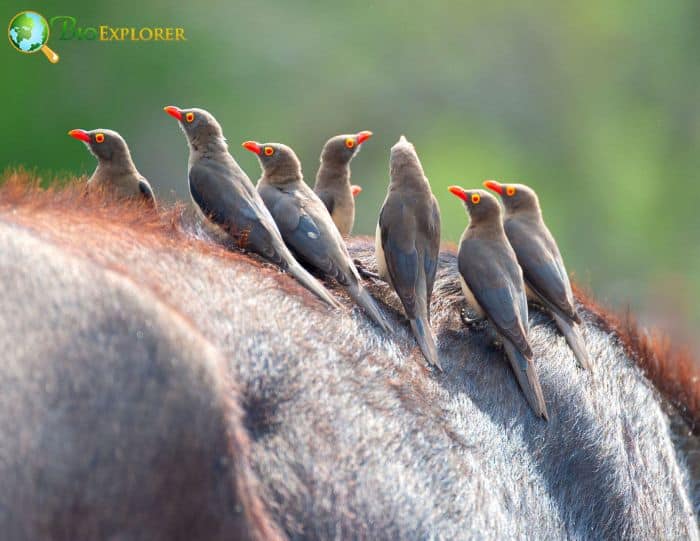
Except in cases where a mate dies, these birds have lifelong relationships. It’s interesting to note that red-billed oxpeckers cooperative breeders.
- This implies that only one breeding pair will incubate the eggs in a group of these birds. The remaining group members, who have frequently grown chicks from the dominant pair’s previous broods, are known as “helpers“.
- The helper’s duties include assisting the new chicks’ in feeding and removing their shells and faecal sacs. This is done to prevent nest-dwelling predators from becoming aware of the chicks.
- Only two species of birds are in the family Buphagidae, including the Red-billed Oxpecker. It is a fairly widespread bird found throughout Sub-Saharan Africa’s savannah grasslands and bushveld regions, from Ethiopia and Somalia down to Mozambique and the northeastern regions of South Africa.
Key Facts and Figures About Red-Billed Oxpeckers
- Scientific Name: Buphagus erythrorhynchus.
- Classification:
- Length: 15-18 cm (6-7 inches).
- Wingspan: Around 30 cm (1 foot).
- Weight: 50-75 g (1.8-2.6 oz).
- Lifespan: Up to 12 years in the wild.
- Population: Estimated at several million overall.
- Range: Sub-Saharan Africa from Sudan and Ethiopia south to South Africa.
- Habitat: Savannas, bushveld, and grasslands.
- Diet: Ticks, insects, larvae, blood, seeds, nestlings.
- Predators: Hawks, eagles, snakes, jackals, genets.
- Nesting: Tree cavities lined with leaves, grass, fur.
- Eggs: Clutch size of 2-5 white eggs with brown speckles.
- Conservation Status: Least Concern on IUCN Red List.
![]()
Fun Facts About the Red-Billed Oxpeckers
- Red-billed Oxpeckers can consume[8] over 100 ticks daily the equivalent of 150% of their body weight!
- They have specially adapted nostrils that can close to keep out dust when perched on mammals.
- Red-billed Oxpeckers spend up to 94% of daylight perching on large wild mammals.
- The red-billed oxpecker has a larger beak and wider wingspan than the yellow-billed oxpecker.
- Their scissor-like claws allow them to grip mammal hide tightly but they can modulate grip strength to avoid harming hosts.
- Oxpeckers can spot predators up to 50-60 meters away while perched atop giraffes.
- They have been observed feeding on earwax and dandruff from mammals as alternative food sources.
- Their nests have been documented surviving in trees for over 15 years and being reused by future generations.
- Oxpeckers will “mob” predators in groups while making loud alarm calls to scare them away.
- Some tribes in Africa believe oxpeckers forecast rain when seen perching on the ground.
- When one mate dies, the other may “widow” themselves by refusing to find a new partner.
- Oxpeckers prefer the taste of large antelope like kudu over cattle.
- Their eggs are small relative to adult size only about 1.5% of the mother’s weight.
- Oxpeckers have been observed feeding on animals as diverse as ostriches and tortoises.
- Adults can completely close their nostrils to keep out dust, while nestlings’ nostrils remain partially open.
![]()
Frequently Asked Questions
What does a red-billed oxpecker do?
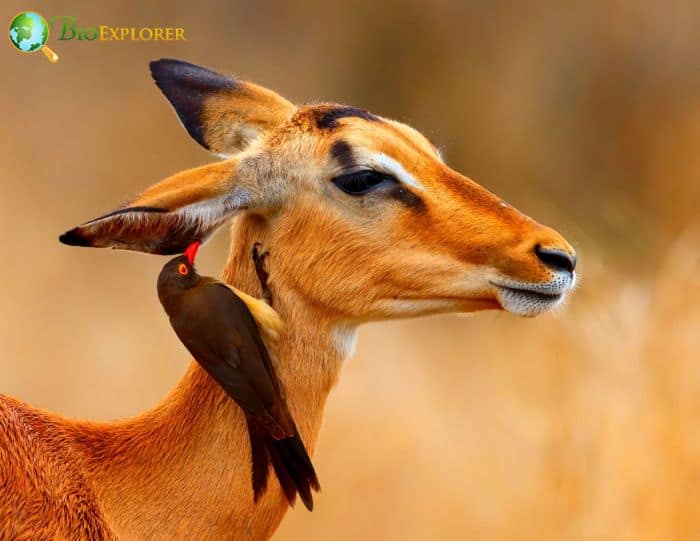
The red-billed oxpecker is a bird species found in Africa. They perch on large wild animals and domesticated cattle and feed almost exclusively on what they can glean from the skin of these mammals, plucking insects and ticks from their hosts. They also use hair plucked from livestock to line their tree-hole nests.
Are red-billed oxpeckers carnivores?
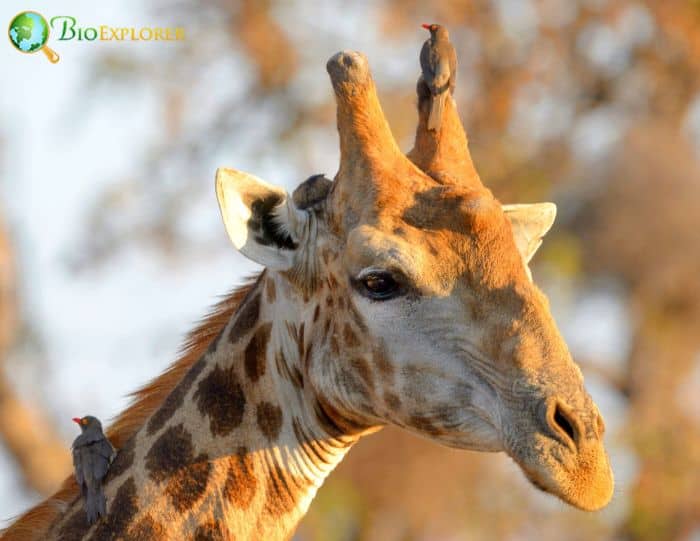
Yes, red-billed oxpeckers are carnivores. They feed almost exclusively on what they can glean from the skin of large African mammals, including ixodid ticks, dead skin, mucus, saliva, blood, sweat, and tears. They also feed on insects such as ticks, flies, worms, and lice.
Are red-billed oxpeckers endangered?
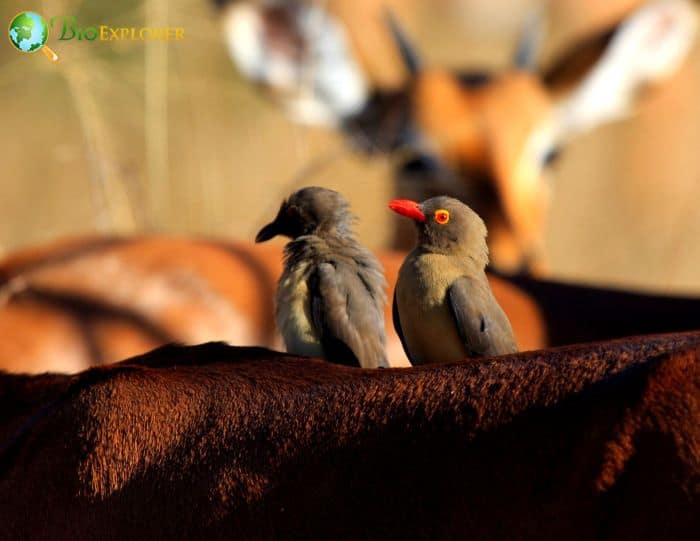
Red-billed oxpeckers are not currently considered endangered. However, they were once considered “near threatened” in South Africa due to a decline in their numbers caused by excessive hunting of their two main hosts, rhinos and buffalos. They are now listed as a species of “least concern” on the IUCN Red List of Threatened Species.
Where are red-billed oxpecker found?
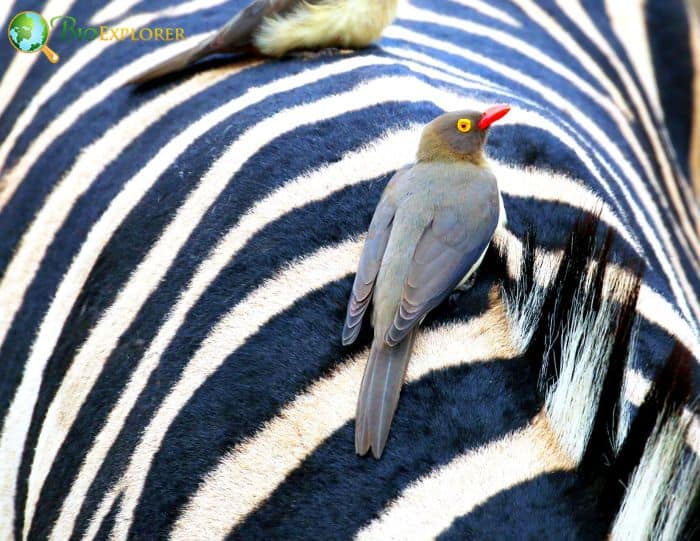
Red-billed oxpeckers are found in the savanna of sub-Saharan Africa. They range from the Central African Republic east to Sudan and south to northern and eastern South Africa. They are found in savanna woodland and farmland, up to 3000 meters, and are absent from forested regions and from arid, treeless areas. They enjoy open savannas, shrubs, and grassy plains. They are also found in shrubland and wetland.
Are oxpeckers parasitic or mutualistic?
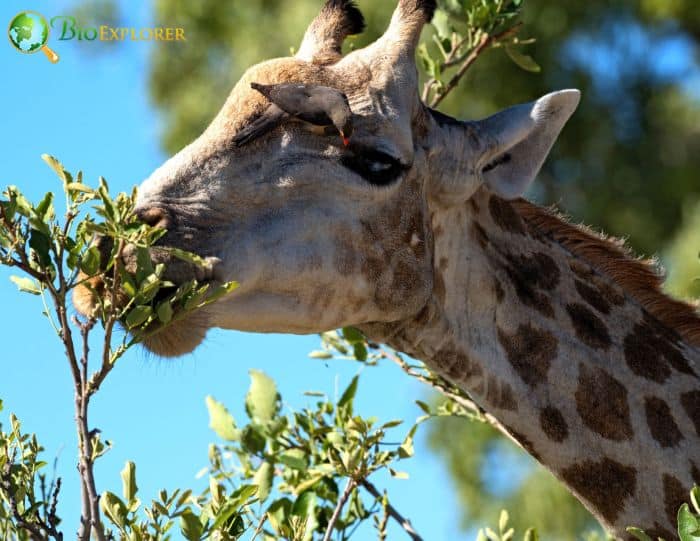
The relationship between oxpeckers and large mammals has been debated, with some considering it mutualistic and others considering it parasitic. Recent research suggests that the relationship can be both mutualistic and parasitic in nature. While they help remove parasites from their hosts, they may also peck at open wounds and consume ungulate tissues, which can cause harm to their hosts.
What advantage does the red-billed oxpecker have why is it an advantage?
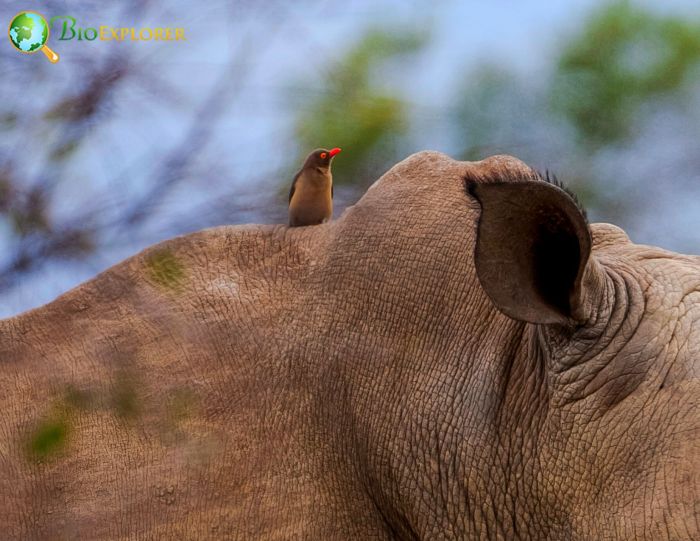
Red-billed oxpeckers have several advantages, including feeding on ticks and other parasites found on large mammals’ backs, which helps reduce tick loads on their hosts. They also consume their hosts’ blood, providing them with a rich source of nutrients. Additionally, they emit a loud warning hiss when they sense danger, which alerts their hosts to potential threats.
What is a red-billed oxpecker?
A red-billed oxpecker, scientifically named Buphagus erythrorynchus, is a passerine bird species in the oxpecker family. It is recognized for its distinctive olive-brown color and, of course, its bright red beak.
Do oxpeckers hurt mammals when pecking them to eat ticks?
Oxpeckers are very strategic in peaking mammals to remove parasites. Their spear-like beaks can carefully extract embedded ticks without causing significant pain or injury to the animals. The cleaning service they provide outweighs minor irritation.
How are oxpeckers able to perch on fast-moving animals like giraffes?
Oxpeckers have several key adaptations that allow them to cling to moving mammals. Their strong, sharp claws and stiff tails provide a firm anchor. They can also modulate their grip strength. Oxpeckers will fly briefly to reposition when hosts move too fast.
Why are oxpeckers important for African ecosystems and biodiversity?
By controlling tick populations and promoting mammal health, oxpeckers enhance ecosystem functioning. Their interdependency with large herbivores influences energy flow and food webs. Oxpeckers fill a unique niche that other species cannot.
Can oxpeckers be tamed or kept as pets?
While young oxpeckers may be hand-raised, they remain challenging pets requiring specific care. Oxpeckers are highly social and thrive in groups, not solitary captivity. It’s best to appreciate oxpeckers in their natural habitat through ecotourism. Removing them from the wild is very risky for their populations.
Where can you find red-billed oxpeckers?
The red-billed oxpecker is native to the savanna of Sub-Saharan Africa. It can be found from the Central African Republic east to Sudan and south to Northern and Eastern South Africa, including Ethiopia and Somalia.
How do red-billed oxpeckers interact with elephants?
The red-billed oxpecker often forms a symbiotic relationship with large mammals such as elephants and cattle. They feed off of the parasites found on these animals’ skin and, in turn, provide a cleaning service for these hosts.
Are red-billed oxpeckers and yellow-billed oxpeckers different?
Yes, they are different species within the same family. They are similar in appearance and behavior but can be easily distinguished by the color of their bill as indicated in their names.
What are some interesting red-billed oxpecker facts?
An interesting fact about the red-billed oxpecker is that while it may appear to be a helpful bird by eating parasites from ungulates, it also feeds on the blood from the wounds of its host animals, often keeping the wounds open for a longer time.
How do red-billed oxpeckers make their nests?
Red-billed oxpeckers are known to nest in tree holes. The nests are typically lined with hair plucked from their host animals. This makes their nests very unique and special to them.
What roles do red-billed oxpeckers play in the Savannah ecosystem?
Red-billed oxpeckers play the role of a cleaner and a “rhino’s guard” in the Savannah. They help larger mammals by feeding on their parasites and alarm these animals of approaching dangers, offering a “security service”.
Are red-billed oxpeckers endangered?
According to BirdLife International, the red-billed oxpecker is not currently endangered and is listed as a species of Least Concern due to its wide distribution and stable population.
What does the diet of a red-billed oxpecker include?
The diet of a red-billed oxpecker primarily consists of ticks and insects found in mammals such as cattle and elephants. However, they have also been known to eat these mammals’ ear wax and wound tissues.
Can red-billed oxpeckers fly?
Yes, red-billed oxpeckers are capable of flight, which allows them to move across the savannah in search of host animals or to flee from predators. They typically fly in tight, direct lines from tree to tree.
![]()


